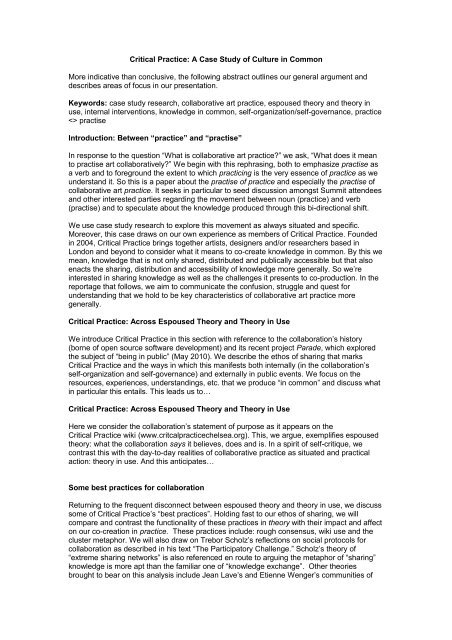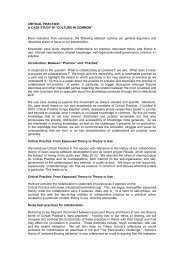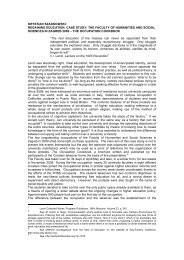Critical Practice: A Case Study of Culture in Common More ...
Critical Practice: A Case Study of Culture in Common More ...
Critical Practice: A Case Study of Culture in Common More ...
You also want an ePaper? Increase the reach of your titles
YUMPU automatically turns print PDFs into web optimized ePapers that Google loves.
<strong>Critical</strong> <strong>Practice</strong>: A <strong>Case</strong> <strong>Study</strong> <strong>of</strong> <strong>Culture</strong> <strong>in</strong> <strong>Common</strong><br />
<strong>More</strong> <strong>in</strong>dicative than conclusive, the follow<strong>in</strong>g abstract outl<strong>in</strong>es our general argument and<br />
describes areas <strong>of</strong> focus <strong>in</strong> our presentation.<br />
Keywords: case study research, collaborative art practice, espoused theory and theory <strong>in</strong><br />
use, <strong>in</strong>ternal <strong>in</strong>terventions, knowledge <strong>in</strong> common, self-organization/self-governance, practice<br />
practise<br />
Introduction: Between “practice” and “practise”<br />
In response to the question “What is collaborative art practice?” we ask, “What does it mean<br />
to practise art collaboratively?” We beg<strong>in</strong> with this rephras<strong>in</strong>g, both to emphasize practise as<br />
a verb and to foreground the extent to which practic<strong>in</strong>g is the very essence <strong>of</strong> practice as we<br />
understand it. So this is a paper about the practise <strong>of</strong> practice and especially the practise <strong>of</strong><br />
collaborative art practice. It seeks <strong>in</strong> particular to seed discussion amongst Summit attendees<br />
and other <strong>in</strong>terested parties regard<strong>in</strong>g the movement between noun (practice) and verb<br />
(practise) and to speculate about the knowledge produced through this bi-directional shift.<br />
We use case study research to explore this movement as always situated and specific.<br />
<strong>More</strong>over, this case draws on our own experience as members <strong>of</strong> <strong>Critical</strong> <strong>Practice</strong>. Founded<br />
<strong>in</strong> 2004, <strong>Critical</strong> <strong>Practice</strong> br<strong>in</strong>gs together artists, designers and/or researchers based <strong>in</strong><br />
London and beyond to consider what it means to co-create knowledge <strong>in</strong> common. By this we<br />
mean, knowledge that is not only shared, distributed and publically accessible but that also<br />
enacts the shar<strong>in</strong>g, distribution and accessibility <strong>of</strong> knowledge more generally. So we’re<br />
<strong>in</strong>terested <strong>in</strong> shar<strong>in</strong>g knowledge as well as the challenges it presents to co-production. In the<br />
reportage that follows, we aim to communicate the confusion, struggle and quest for<br />
understand<strong>in</strong>g that we hold to be key characteristics <strong>of</strong> collaborative art practice more<br />
generally.<br />
<strong>Critical</strong> <strong>Practice</strong>: Across Espoused Theory and Theory <strong>in</strong> Use<br />
We <strong>in</strong>troduce <strong>Critical</strong> <strong>Practice</strong> <strong>in</strong> this section with reference to the collaboration’s history<br />
(borne <strong>of</strong> open source s<strong>of</strong>tware development) and its recent project Parade, which explored<br />
the subject <strong>of</strong> “be<strong>in</strong>g <strong>in</strong> public” (May 2010). We describe the ethos <strong>of</strong> shar<strong>in</strong>g that marks<br />
<strong>Critical</strong> <strong>Practice</strong> and the ways <strong>in</strong> which this manifests both <strong>in</strong>ternally (<strong>in</strong> the collaboration’s<br />
self-organization and self-governance) and externally <strong>in</strong> public events. We focus on the<br />
resources, experiences, understand<strong>in</strong>gs, etc. that we produce “<strong>in</strong> common” and discuss what<br />
<strong>in</strong> particular this entails. This leads us to…<br />
<strong>Critical</strong> <strong>Practice</strong>: Across Espoused Theory and Theory <strong>in</strong> Use<br />
Here we consider the collaboration’s statement <strong>of</strong> purpose as it appears on the<br />
<strong>Critical</strong> <strong>Practice</strong> wiki (www.critcalpracticechelsea.org). This, we argue, exemplifies espoused<br />
theory: what the collaboration says it believes, does and is. In a spirit <strong>of</strong> self-critique, we<br />
contrast this with the day-to-day realities <strong>of</strong> collaborative practice as situated and practical<br />
action: theory <strong>in</strong> use. And this anticipates…<br />
Some best practices for collaboration<br />
Return<strong>in</strong>g to the frequent disconnect between espoused theory and theory <strong>in</strong> use, we discuss<br />
some <strong>of</strong> <strong>Critical</strong> <strong>Practice</strong>’s “best practices”. Hold<strong>in</strong>g fast to our ethos <strong>of</strong> shar<strong>in</strong>g, we will<br />
compare and contrast the functionality <strong>of</strong> these practices <strong>in</strong> theory with their impact and affect<br />
on our co-creation <strong>in</strong> practice. These practices <strong>in</strong>clude: rough consensus, wiki use and the<br />
cluster metaphor. We will also draw on Trebor Scholz’s reflections on social protocols for<br />
collaboration as described <strong>in</strong> his text “The Participatory Challenge.” Scholz’s theory <strong>of</strong><br />
“extreme shar<strong>in</strong>g networks” is also referenced en route to argu<strong>in</strong>g the metaphor <strong>of</strong> “shar<strong>in</strong>g”<br />
knowledge is more apt than the familiar one <strong>of</strong> “knowledge exchange”. Other theories<br />
brought to bear on this analysis <strong>in</strong>clude Jean Lave’s and Etienne Wenger’s communities <strong>of</strong>
practice and the homespun pragmatism that marks <strong>Critical</strong> <strong>Practice</strong>’s broader approach. And<br />
this br<strong>in</strong>gs us to…<br />
Reiterat<strong>in</strong>g <strong>Critical</strong> <strong>Practice</strong><br />
Based on the <strong>in</strong>sights ga<strong>in</strong>ed through our research for sections 1 and 2, section 3 proposes a<br />
“new” statement <strong>of</strong> practice for <strong>Critical</strong> <strong>Practice</strong>. This reiteration seeks to open up the rhetoric<br />
and groupth<strong>in</strong>k that can cripple the collaboration when assumptions are made regard<strong>in</strong>g what<br />
knowledge is shared.<br />
By way <strong>of</strong> conclusion: a new beg<strong>in</strong>n<strong>in</strong>g<br />
Our presentation concludes by suggest<strong>in</strong>g the broader significance <strong>of</strong> this case study for<br />
other groups and <strong>in</strong>dividuals <strong>in</strong>terested <strong>in</strong> collaboratively produced knowledge based on an<br />
ethos <strong>of</strong> shar<strong>in</strong>g. We speculate that case studies conducted by <strong>in</strong>dividual members and/or<br />
small groups with<strong>in</strong> an organization can be powerful <strong>in</strong>ternal <strong>in</strong>terventions for destabiliz<strong>in</strong>g<br />
assumptions and propos<strong>in</strong>g alternative ways <strong>of</strong> work<strong>in</strong>g, know<strong>in</strong>g and be<strong>in</strong>g together. Hence<br />
they can be valuable for an organization’s history and development.<br />
We suggest that one way <strong>of</strong> <strong>in</strong>terpret<strong>in</strong>g case studies is as a refusal, a refusal to accept that<br />
knowledge held <strong>in</strong> common can ever be codified. For it to be <strong>in</strong> common—that is available to<br />
anyone—it must confound the proprietary forces that seek to p<strong>in</strong> it down and make it resonate<br />
with partial significance. So, <strong>in</strong> fact and somewhat paradoxically, what dist<strong>in</strong>guishes<br />
knowledge <strong>in</strong> common (<strong>in</strong> <strong>Critical</strong> <strong>Practice</strong>) is not so much that it belongs to everyone but that<br />
it belongs to no one; as such, it can be available to anyone, taken up and explored by<br />
<strong>in</strong>dividuals <strong>in</strong> their own way. This openness, we argue, is a political act. When, for <strong>in</strong>stance,<br />
<strong>in</strong>dividuals and small groups make <strong>in</strong>ternal <strong>in</strong>terventions by way <strong>of</strong> case studies like this one,<br />
they frustrate the larger organization’s attempts to <strong>in</strong>strumentalize its own practice for the<br />
sake <strong>of</strong> stabiliz<strong>in</strong>g a shared identity. In this way, these <strong>in</strong>terventions <strong>in</strong>culcate an ethos <strong>of</strong><br />
collaborative practise as someth<strong>in</strong>g that can never be taken for granted. At its best, this hyper<br />
reflective and reflexive practise is groundless. Instead <strong>of</strong> conform<strong>in</strong>g to best practices and/or<br />
explicit guidel<strong>in</strong>es, it takes shape through <strong>in</strong>teractions among the differential desires and<br />
respective competencies <strong>of</strong> the various collaborators who br<strong>in</strong>g it <strong>in</strong>to be<strong>in</strong>g.





